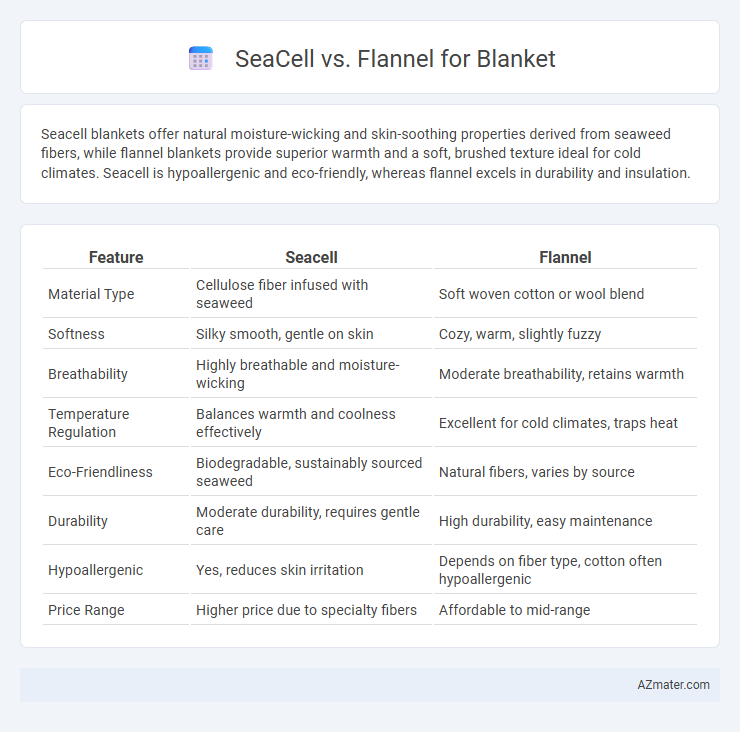Seacell blankets offer natural moisture-wicking and skin-soothing properties derived from seaweed fibers, while flannel blankets provide superior warmth and a soft, brushed texture ideal for cold climates. Seacell is hypoallergenic and eco-friendly, whereas flannel excels in durability and insulation.
Table of Comparison
| Feature | Seacell | Flannel |
|---|---|---|
| Material Type | Cellulose fiber infused with seaweed | Soft woven cotton or wool blend |
| Softness | Silky smooth, gentle on skin | Cozy, warm, slightly fuzzy |
| Breathability | Highly breathable and moisture-wicking | Moderate breathability, retains warmth |
| Temperature Regulation | Balances warmth and coolness effectively | Excellent for cold climates, traps heat |
| Eco-Friendliness | Biodegradable, sustainably sourced seaweed | Natural fibers, varies by source |
| Durability | Moderate durability, requires gentle care | High durability, easy maintenance |
| Hypoallergenic | Yes, reduces skin irritation | Depends on fiber type, cotton often hypoallergenic |
| Price Range | Higher price due to specialty fibers | Affordable to mid-range |
Introduction to Seacell and Flannel Fabrics
Seacell fabric is a sustainable textile made from a blend of cellulose fibers derived from seaweed and other natural sources, known for its softness, breathability, and skin-nourishing properties due to the presence of bioactive compounds. Flannel fabric is a soft, warm textile typically woven from cotton, wool, or synthetic fibers, characterized by its fuzzy, brushed surface that provides excellent insulation and comfort in colder climates. Both fabrics are popular choices for blankets, with Seacell offering eco-friendly moisture-wicking benefits and Flannel delivering superior warmth and coziness.
What is Seacell? Composition and Benefits
Seacell is a textile fiber infused with sustainably harvested seaweed, primarily composed of cellulose and natural algae extracts, offering enhanced skin nourishment and moisture retention. This innovative material provides anti-inflammatory and antioxidant properties, making Seacell blankets highly beneficial for sensitive skin and overall comfort. Compared to traditional flannel, which is usually made from cotton or wool with a soft, brushed texture, Seacell blends eco-friendly marine nutrients with fabric technology for added wellness advantages.
Flannel: Origins and Key Properties
Flannel, originally developed in Wales, is known for its soft, napped finish that provides exceptional warmth and comfort in blankets. Made primarily from cotton or wool, flannel fibers are tightly woven and then brushed to create a fuzzy texture, enhancing insulation and breathability. This fabric's moisture-wicking properties and light weight make it ideal for maintaining cozy warmth without overheating.
Softness and Comfort Comparison
Seacell blankets offer exceptional softness due to their blend of natural cellulose fibers derived from seaweed combined with cotton, providing a smooth, breathable texture that adapts to body temperature for enhanced comfort. Flannel blankets, made from tightly woven cotton or wool fibers, are renowned for their warmth and plush, brushed surface that delivers a cozy, insulating feel. While Seacell excels in moisture-wicking and hypoallergenic properties, flannel blankets prioritize thick, fuzzy warmth that retains heat effectively during cold weather.
Breathability and Moisture Management
Seacell blankets excel in breathability due to their natural seaweed-infused fibers, which promote airflow and regulate temperature effectively. Flannel blankets, made from tightly woven cotton or wool, offer moderate breathability but can trap heat more easily than Seacell, leading to less moisture evaporation. For moisture management, Seacell's antiviral and moisture-wicking properties help keep the skin dry, while flannel absorbs moisture but dries slower, potentially causing dampness under extended use.
Warmth and Thermal Efficiency
Seacell blankets, infused with seaweed fibers, offer natural moisture-wicking and temperature-regulating properties that enhance warmth without overheating. Flannel blankets provide superior insulation due to their napped cotton fabric, trapping heat effectively for cozy thermal retention. When comparing thermal efficiency, flannel excels in cold climates, while Seacell's breathable warmth suits milder conditions with added skin benefits.
Eco-Friendliness and Sustainability
Seacell blankets are crafted from a blend of natural seaweed fibers and organic cotton, enhancing biodegradability and minimizing environmental impact through renewable resources. Flannel blankets, typically made from cotton or wool, offer durability and warmth but may involve more intensive water and energy consumption depending on production methods. Choosing Seacell blankets supports eco-friendliness due to their sustainable seaweed integration, while flannel's sustainability varies with fiber sourcing and manufacturing practices.
Durability and Long-Term Use
Seacell blankets are crafted from seaweed-infused fibers combined with cotton, offering natural antimicrobial properties and moderate durability suitable for gentle use. Flannel blankets, known for their densely woven cotton or wool fibers, provide superior durability and resistance to wear over prolonged use and frequent washing. For long-term use, flannel blankets generally maintain texture and warmth better, making them a preferred choice for durability-focused consumers.
Care and Maintenance Differences
Seacell blankets require gentle washing with cold water and mild detergent to preserve the fabric's bioactive properties, while flannel blankets tolerate more robust care, including warm water washes and frequent laundering without damage. Seacell's delicate fibers may lose their softness and function if exposed to bleach or high heat, whereas flannel is more resistant to shrinking and pilling, making it easier to maintain over time. Optimal care for Seacell emphasizes air drying and avoiding tumble drying, contrasting with flannel's ability to handle machine drying at low to medium heat settings.
Final Verdict: Which Blanket Fabric to Choose?
Seacell blankets offer superior moisture-wicking and anti-bacterial properties due to the integration of seaweed fibers, making them ideal for those seeking skin-friendly and eco-conscious options. Flannel blankets provide exceptional warmth and softness with their brushed cotton texture, perfect for cold climates and cozy settings. Choose Seacell for breathable, sustainable comfort or Flannel for plush insulation and classic warmth based on your specific needs.

Infographic: Seacell vs Flannel for Blanket
 azmater.com
azmater.com